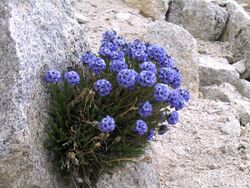Biology:Polemonium eximium
| Polemonium eximium | |
|---|---|

| |
| Scientific classification | |
| Kingdom: | Plantae |
| Clade: | Tracheophytes |
| Clade: | Angiosperms |
| Clade: | Eudicots |
| Clade: | Asterids |
| Order: | Ericales |
| Family: | Polemoniaceae |
| Genus: | Polemonium |
| Species: | P. eximium
|
| Binomial name | |
| Polemonium eximium Greene
| |
Polemonium eximium, the skypilot[1] or showy sky pilot,[2] is a perennial plant in the phlox family (Polemoniaceae) that grows at high altitudes (mostly above 10,000 feet (3,000 m)).[3] It is endemic to the Sierra Nevada in California where it grows in the talus of the high mountain slopes.[3][4]
Wildflower enthusiasts consider it to be among the best of the Sierra wildflowers, and highly rewarding to find.[3]
Habitat and range
It mostly occurs at elevations from 10,000 to 14,000 feet (3,000 to 4,300 m) in the Central and Southern Sierra Nevada.[3][5] It mostly occurs in colonies in stark surroundings, above 10,000 feet (3,000 m), in rocky areas that appear mostly devoid of soil, and rarely in association with other plants.[3]
Most notably, it can be found at the upper reaches of Mt. Whitney, both via the main trail and mountaineer's route, as well as the southern flanks of Mt Langley in the Inyo National Forest. Additionally, it resides near the summit of Mount Dana in Yosemite National Park.[3]
Description
Growth pattern
It is a sticky, aromatic smelling, 4 to 16 inches (10 to 41 cm) tall perennial plant with a woody base, from which grows clumps of erect stems .[5]
Leaves and stems
Basal leaves are glandular-hairy, 4–13 centimetres (1.6–5.1 in) long, and 4–9 centimetres (1.6–3.5 in) wide, each made up of 20–35 leaflets,[5] which in turn are subdivided into 3–5 lobes.[6]
Inflorescence and fruit
The showy inflorescence is a crowded head of many flowers.[5] The bright deep blue to whitish-blue to pink-lavender flowers are fragrant.[3] Each flower has a tubular calyx of hairy sepals and a funnel-shaped corolla spreading to lobes.[5] The flowers are at full bloom for approximately one day apiece in the very short period of appropriate flowering conditions.[7] The plant has a strong scent reminiscent of urine which attracts pollinators to its short-lived flowers.[7] It blooms from June to August.[5]
References
- ↑ "Polemonium eximium". Natural Resources Conservation Service PLANTS Database. USDA. https://plants.usda.gov/core/profile?symbol=POEX. Retrieved 9 September 2014.
- ↑ "Taxon Report 6714, Polemonium eximium". Calflora. http://www.calflora.org/cgi-bin/species_query.cgi?where-calrecnum=6714. Retrieved 2 December 2014.
- ↑ 3.0 3.1 3.2 3.3 3.4 3.5 3.6 Sierra Nevada Wildflowers, Elizabeth Horn, Mountain Press Publishing Co., ISBN:0878423885, 1998, p. 126
- ↑ Sierra Nevada Wildflowers, Karen Wiese, 2nd ed., 2013
- ↑ 5.0 5.1 5.2 5.3 5.4 5.5 Philip A. Munz (2003). Dianne Lake. ed. Introduction to California Mountain Wildflowers. University of California Press. ISBN 0520236351.
- ↑ "Polemonium eximium". Jepson Flora Project. http://ucjeps.berkeley.edu/cgi-bin/get_IJM.pl?tid=38977. Retrieved 2 December 2014.
- ↑ 7.0 7.1 The Outdoors Digest Field Guide - Sky Pilot. Los Angeles Times.
External links
Wikidata ☰ Q7209290 entry
 |

